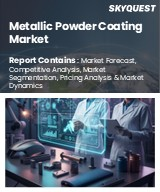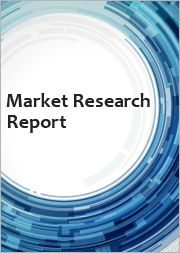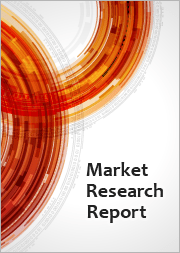
|
시장보고서
상품코드
1734894
세계의 항균 유리 파우더 시장 예측(-2032년) : 제품별, 형상별, 사이즈별, 용도별, 최종 사용자별, 지역별 분석Antimicrobial Glass Powder Market Forecasts to 2032 - Global Analysis By Product (Copper, Silver, Zinc, Metal Oxide-based, Photocatalytic and Bioactive-based), Form, Size, Application, End User and By Geography |
||||||
Stratistics MRC에 따르면, 세계의 항균 유리 파우더 시장은 2025년 32억 3,000만 달러를 차지하고, 예측 기간 동안 CAGR 9.5%로 성장하여 2032년에는 61억 1,000만 달러에 이를 전망입니다.
항균 유리 파우더는 은 이온, 구리 이온, 아연 이온 등의 항균제를 반죽한 특수한 재료로, 세균, 진균, 기타 유해한 미생물의 증식을 억제합니다. 식품 가공, 헬스케어 환경에서 내구성 있는 위생적인 보호를 제공합니다. 또한, 항균 유리 파우더는 특히 세계의 건강에 대한 우려와 항균 솔루션에 대한 수요의 높아짐에 따라, 장수명, 안전성, 다양한 상업 용도나 소비자용도에의 적응성에 의해 인기가 높아지고 있습니다.
미국 질병 예방관리센터(CDC)의 데이터에 따르면, 헬스케어 관련 감염(HAI)은 미국에서 매일 병원 환자의 약 31명 중 1명이 이환하고 있습니다.
건강 관리와 관련된 감염(HAI) 증가
세계 건강 관리 시설은 의료 관련 감염에 큰 우려를 갖고 있습니다. 항균 유리 파우더를 포함한 소재가 벽 패널, 수술대, 침대 난간, 의료기기에 도입되고 있습니다. 또한, 이 파우더는 표면의 미생물 부하를 저하시키기 때문에 감염 제어 전략의 필수 요소가 되고 있습니다.
엄청난 재료비와 제조비용
항균 유리 분말의 제조 비용이 비교적 높은 것이 주요 장벽 중 하나입니다.이 원료의 비용이 높기 때문에 구리, 아연, 은 등의 금속 이온을 첨가하면 제조 비용이 크게 상승합니다. 이러한 비용은 궁극적으로 소비자에게 전가되기 때문에 특히 소비자가 가격에 민감한 시장과 비용 효과를 가장 중요시하는 용도에서는 항균 유리 제품의 이용성이 저하됩니다.
장기 감염 예방에 대한 관심 증가
COVID-19의 대유행은 소비자와 기업의 감염 대책에 대한 생각을 근본적으로 바꿨습니다. 또한 식품 가공, 의약품 포장, 노인 간호 시설 등의 분야에서 견고한 항균 인프라에 대한 투자가 증가하고 있기 때문에 유리 분말 공급업체는 현재 장기 판매 채널을 가지고 있습니다.
항균제 대체 기술과의 경쟁
항균 폴리머 첨가제, 나노 코팅, 광촉매 표면(TiO2와 같은), UV 기반 살균 시스템과 같은 새로운 기술은 항균 유리 파우더에 심각한 위협이 될 것입니다. 한편, 도포 절차가 간단하거나 저렴할 수 있습니다. 또한, 이들 중 많은 부분은 유리계 재료가 부적절한 일시적인 표면이나 유연한 기재에 사용할 수 있기 때문에 재료의 유연성이 중요한 산업에서는 경쟁적으로 불리해집니다.
COVID-19의 영향:
COVID-19의 대유행은 공공 인프라, 헬스케어, 소비자용 분야에 있어서의 내구 위생 제품에 대한 수요를 세계적으로 크게 밀어 올려, 항균 유리 파우더 시장의 추풍이 되었습니다. 게다가, 표면으로부터의 바이러스 감염에 대한 인식이 높아졌기 때문에 병원, 진단 랩, 클린 룸 환경에서는 감염을 막기 위해서 항균 표면을 요구하는 경향이 강해져, 소매업, 접객업, 운수업 등의 상업 업계에서는 고객을 지키기 위해서 이러한 재료를 연구하고 있었습니다.
구리 부문이 예측 기간 동안 최대가 될 전망
구리 부문은 예측 기간 동안 가장 큰 시장 점유율을 차지할 것으로 예측됩니다. 바이러스, 진균, 박테리아에 대해 폭넓은 스펙트럼 활성을 가지며, 효과가 장기간 지속되는 것으로 유명합니다 은에 비해 제조 비용이 비교적 싸고, 사람의 출입이 많은 환경에서도 미생물의 번식을 억제할 수 있기 때문에 다양한 항균 용도로 압도적인 지위를 차지하고 있습니다.
예측 기간 동안 CAGR이 가장 높을 것으로 예상되는 코팅 분야
예측 기간 동안 코팅 분야가 가장 높은 성장률을 보일 것으로 예측됩니다. 섬유, 금속, 유리, 플라스틱 등 다양한 표면에 도포할 수 있어 미생물의 증식에 대한 내구성이 있는 방어를 제공합니다. 또한, 항균 코팅은 건물, 자동차, 기기의 외면이나 내면에 도포할 수 있는 범용성의 높이로부터, 다양한 상업시설이나 주택에서 인기가 높아지고 있습니다.
최대 점유율을 차지하는 지역
예측 기간 동안 북미가 최대 시장 점유율을 차지할 것으로 예상되며, 이는 소비재, 건설, 헬스케어 분야가 최첨단 항균 솔루션을 강하게 요구하고 있기 때문입니다. 게다가 북미가 시장에서 압도적인 지위를 차지하고 있는 것은 중요한 제조업체의 존재, 집중적인 연구개발 노력, 항균 표면의 이점에 대한 의식의 고조의 결과이기도 하고, 유행 후 장기적인 위생 솔루션에 주목한 결과, 이 분야 수요도 증가하고 있습니다.
CAGR이 가장 높은 지역:
예측 기간 동안 아시아태평양이 가장 높은 CAGR을 나타낼 것으로 예측됩니다. 이 확대는 특히 중국, 인도, 일본 등의 국가에서 급속한 도시화, 산업화, 건강 및 위생 의식의 고조에 의해 초래됩니다. 시장의 확대는 전자공학, 건설, 식품포장, 헬스케어 분야에서 항균 솔루션에 대한 요구의 고조가 원동력이 되고 있습니다. 게다가 유리한 정부 규제, 건강 관리 시설에 대한 투자, 위생을 걱정하는 중간층이 증가함에 따라 항균 유리 파우더 제품의 사용이 급속히 확대되고 있습니다.
무료 맞춤 서비스
이 보고서를 구독하는 고객은 다음과 같은 무료 맞춤설정 옵션 중 하나를 제공합니다.
- 기업 프로파일
- 추가 시장 기업의 종합적 프로파일링(3개사까지)
- 주요 기업의 SWOT 분석(3개사까지)
- 지역 세분화
- 고객의 관심에 응한 주요국 시장 추계, 예측, CAGR(주: 타당성 확인에 따름)
- 경쟁 벤치마킹
- 제품 포트폴리오, 지리적 존재, 전략적 제휴에 기반한 주요 기업 벤치마킹
목차
제1장 주요 요약
제2장 서문
- 개요
- 이해관계자
- 조사 범위
- 조사 방법
- 데이터 마이닝
- 데이터 분석
- 데이터 검증
- 조사 접근
- 조사 자료
- 1차 조사 자료
- 2차 조사 정보원
- 전제조건
제3장 시장 동향 분석
- 성장 촉진요인
- 억제요인
- 기회
- 위협
- 제품분석
- 용도 분석
- 최종 사용자 분석
- 신흥 시장
- COVID-19의 영향
제4장 Porter's Five Forces 분석
- 공급기업의 협상력
- 구매자의 협상력
- 대체품의 위협
- 신규 참가업체의 위협
- 경쟁 기업간 경쟁 관계
제5장 세계의 항균 유리 파우더 시장 : 제품별
- 구리
- 은
- 아연
- 금속 산화물 베이스
- 광촉매
- 바이오 액티브 베이스
제6장 세계의 항균 유리 파우더 시장 : 형태별
- 분말
- 과립
- 코팅
제7장 세계의 항균 유리 파우더 시장 : 규모별
- 나노 사이즈
- 마이크로 사이즈
제8장 세계의 항균 유리 파우더 시장 : 용도별
- 페인트 및 코팅
- 플라스틱 및 폴리머
- 섬유 및 텍스타일
- 퍼스널케어 및 화장품
- 기타 용도
제9장 세계의 항균 유리 파우더 시장 : 최종 사용자별
- 헬스케어
- 가전
- 패키지
- 건축 및 건설
- 주택
- 상업
- 산업
- 기타 최종 사용자
제10장 세계의 항균 유리 파우더 시장 : 지역별
- 북미
- 미국
- 캐나다
- 멕시코
- 유럽
- 독일
- 영국
- 이탈리아
- 프랑스
- 스페인
- 기타 유럽
- 아시아태평양
- 일본
- 중국
- 인도
- 호주
- 뉴질랜드
- 한국
- 기타 아시아태평양
- 남미
- 아르헨티나
- 브라질
- 칠레
- 기타 남미
- 중동 및 아프리카
- 사우디아라비아
- 아랍에미리트(UAE)
- 카타르
- 남아프리카
- 기타 중동 및 아프리카
제11장 주요 발전
- 계약, 파트너십, 협업, 합작투자
- 인수합병
- 신제품 발매
- 사업 확대
- 기타 주요 전략
제12장 기업 프로파일링
- Hongwu International Group Ltd
- American Elements Inc
- Nippon Electric Glass Co., Ltd.
- LG Electronics
- Schott AG
- Ishizuka Glass Co., Ltd.
- Wienerberger AG
- Koshida Corporation.
- AGC Inc.
- PPG Industries, Inc.
- BioCote Limited
- Saint-Gobain
- Asahi Glass Co., Ltd.
- Corning Inc
- Vedayukt India Private Limited
According to Stratistics MRC, the Global Antimicrobial Glass Powder Market is accounted for $3.23 billion in 2025 and is expected to reach $6.11 billion by 2032 growing at a CAGR of 9.5% during the forecast period. Antimicrobial glass powder is a specialized material infused with antimicrobial agents, such as silver, copper, or zinc ions, that inhibit the growth of bacteria, fungi, and other harmful microorganisms. This powder is frequently added to paints, coatings, ceramics, and plastics to offer durable hygienic protection in high-touch surface settings, food processing, and healthcare settings. Moreover, antimicrobial glass powder is becoming more popular due to its longevity, safety, and adaptability in a range of commercial and consumer applications, particularly in the wake of global health concerns and the growing demand for antimicrobial solutions.
According to data from the U.S. Centers for Disease Control and Prevention (CDC), healthcare-associated infections (HAIs) affect approximately 1 in 31 hospital patients daily in the United States. This statistic underscores the critical need for antimicrobial materials, such as antimicrobial glass powder, in healthcare settings to mitigate the spread of infections.
Market Dynamics:
Driver:
Rise in infections associated with healthcare (HAIs)
Hospitals and other healthcare facilities around the world are very concerned about infections linked to healthcare. The CDC estimates that HAIs cause billions of dollars in medical expenses and tens of thousands of deaths each year. To make clinical spaces safer, materials containing antimicrobial glass powder are being incorporated into wall panels, operating tables, bed rails, and medical equipment. Additionally, the powder is an essential component of infection control strategies because it lowers the microbial load on surfaces.
Restraint:
Exorbitant material and production costs
The comparatively high cost of producing antimicrobial glass powder is one of the main barriers. Due to the high cost of these raw materials, adding metal ions such as copper, zinc, or silver raises production costs considerably. Furthermore, advanced machinery and energy-intensive procedures are needed for the technology needed to evenly embed these ions into the glass matrix. These expenses are eventually transferred to the final consumer, which reduces the availability of antimicrobial glass products, especially in markets where consumers are price conscious or in applications where cost-effectiveness is a top concern.
Opportunity:
Growing attention to preventing long-term infections
The COVID-19 pandemic has radically changed how consumers and businesses think about infection control. Long-term, passive hygiene solutions that need little human involvement are currently gaining traction. This need is satisfied by antimicrobial glass powder because of its durability and resistance to deterioration and washing. Moreover, glass powder suppliers now have long-term sales channels owing to growing investments in robust antimicrobial infrastructure from sectors like food processing, pharmaceutical packaging, and elder care facilities.
Threat:
Competition from alternative technologies for antimicrobials
Emerging technologies like antimicrobial polymer additives, nanocoatings, photo catalytic surfaces (like TiO2), and UV-based sterilization systems pose a serious threat to antimicrobial glass powder. These substitutes might have easier application procedures or be less expensive while providing comparable or better antimicrobial activity. Furthermore, many of them can be used on temporary surfaces or flexible substrates where glass-based materials are inappropriate, which puts them at a competitive disadvantage in industries where material flexibility is crucial.
Covid-19 Impact:
The COVID-19 pandemic significantly boosted the demand for durable hygiene products worldwide in the public infrastructure, healthcare, and consumer-facing sectors, which in turn helped the antimicrobial glass powder market. Increased interest in antimicrobial materials that could passively lower the microbial load without requiring continuous disinfection resulted from increased awareness of surface-based virus transmission. Moreover, hospitals, diagnostic labs, and clean room settings were looking for antimicrobial surfaces more and more to prevent infections, and commercial industries like retail, hospitality, and transportation were investigating these materials to protect their customers.
The copper segment is expected to be the largest during the forecast period
The copper segment is expected to account for the largest market share during the forecast period. Copper ions are a popular option for uses in public infrastructure, food packaging, and healthcare because of their exceptional ability to break down microbial cell membranes and enzymes. Antimicrobial glass powder based on copper is renowned for its broad-spectrum activity and long-lasting effectiveness against viruses, fungi, and bacteria. Because of its comparatively low production cost when compared to silver and its capacity to inhibit microbial growth even in high-traffic environments, it holds a dominant market position in a variety of antimicrobial applications.
The coatings segment is expected to have the highest CAGR during the forecast period
Over the forecast period, the coatings segment is predicted to witness the highest growth rate. This is fueled by the expanding need for long-lasting, affordable, and simple-to-apply antimicrobial solutions in sectors like food packaging, healthcare, and construction. Enhanced flexibility is provided by antimicrobial coatings, which can be applied to a variety of surfaces, such as textiles, metals, glass, and plastics, and offer durable defense against microbial growth. Moreover, they are becoming more and more popular in a variety of commercial and residential settings due to their versatility, which allows them to be applied to the outside and inside surfaces of buildings, cars, and equipment.
Region with largest share:
During the forecast period, the North America region is expected to hold the largest market share, driven by the consumer goods, construction, and healthcare sectors' strong need for cutting-edge antimicrobial solutions. The adoption of antimicrobial materials has been accelerated by the region's strong emphasis on infection control, hygiene, and regulatory standards in both the public and private sectors. Additionally, North America's dominant market position is also a result of the presence of important manufacturers, intensive research and development efforts, and growing awareness of the advantages of antimicrobial surfaces and the demand in this area has also increased as a result of the post-pandemic focus on long-term hygiene solutions.
Region with highest CAGR:
Over the forecast period, the Asia Pacific region is anticipated to exhibit the highest CAGR. This expansion is driven by fast urbanization, industrialization, and rising health and hygiene consciousness, especially in nations like China, India, and Japan. The expansion of the market is being driven by the increasing need for antimicrobial solutions in the electronics, construction, food packaging, and healthcare sectors. Furthermore, the use of antimicrobial glass powder products is growing faster due to favorable government regulations, investments in healthcare facilities, and an increase in the middle class that is concerned about hygiene.
Key players in the market
Some of the key players in Antimicrobial Glass Powder Market include Hongwu International Group Ltd, American Elements Inc, Nippon Electric Glass Co., Ltd., LG Electronics, Schott AG, Ishizuka Glass Co., Ltd., Wienerberger AG, Koshida Corporation., AGC Inc., PPG Industries, Inc., BioCote Limited, Saint-Gobain, Asahi Glass Co., Ltd., Corning Inc and Vedayukt India Private Limited.
Key Developments:
In April 2025, LG Electronics signed a memorandum of understanding (MOU) with KEPCO and Hanwha Engineering & Construction on the 24th at Hanwha Building in Jung-gu, Seoul to build a direct current-based data center and create an ecosystem. The three companies will promote a demonstration project to supply 1MW of data center servers and cooling facilities with DC power.
In March 2025, AGC Biologics announced the company won two awards from the annual CDMO Leadership awards, sponsored by Outsourced Pharma and Life Science Connect. AGC Biologics was named a winner in both the "Biologics - Global" and "Cell & Gene - Global" categories and is one of the few in the industry that scored high enough to be honored in multiple categories.
In November 2023, Schott and Accelink announced a strategic partnership by signing a long-term cooperation agreement at the China International Import Expo (CIIE) 2023. This collaboration is poised to strengthen the fiber optic communication supply chain and grow the field's technological capabilities. Under the new agreement, SCHOTT will provide Accelink with transistor outline (TO) packages, which are key components of optical communication devices.
Products Covered:
- Copper
- Silver
- Zinc
- Metal Oxide-based
- Photocatalytic
- Bioactive-based
Forms Covered:
- Powder
- Granules
- Coatings
Sizes Covered:
- Nano-sized
- Micro-sized
Applications Covered:
- Paints & Coatings
- Plastics & Polymers
- Fiber & Textiles
- Personal Care & Cosmetics
- Other Applications
End Users Covered:
- Healthcare
- Consumer Electronics
- Packaging
- Building and Construction
- Residential
- Commercial
- Industrial
- Other End Users
Regions Covered:
- North America
- US
- Canada
- Mexico
- Europe
- Germany
- UK
- Italy
- France
- Spain
- Rest of Europe
- Asia Pacific
- Japan
- China
- India
- Australia
- New Zealand
- South Korea
- Rest of Asia Pacific
- South America
- Argentina
- Brazil
- Chile
- Rest of South America
- Middle East & Africa
- Saudi Arabia
- UAE
- Qatar
- South Africa
- Rest of Middle East & Africa
What our report offers:
- Market share assessments for the regional and country-level segments
- Strategic recommendations for the new entrants
- Covers Market data for the years 2024, 2025, 2026, 2028, and 2032
- Market Trends (Drivers, Constraints, Opportunities, Threats, Challenges, Investment Opportunities, and recommendations)
- Strategic recommendations in key business segments based on the market estimations
- Competitive landscaping mapping the key common trends
- Company profiling with detailed strategies, financials, and recent developments
- Supply chain trends mapping the latest technological advancements
Free Customization Offerings:
All the customers of this report will be entitled to receive one of the following free customization options:
- Company Profiling
- Comprehensive profiling of additional market players (up to 3)
- SWOT Analysis of key players (up to 3)
- Regional Segmentation
- Market estimations, Forecasts and CAGR of any prominent country as per the client's interest (Note: Depends on feasibility check)
- Competitive Benchmarking
- Benchmarking of key players based on product portfolio, geographical presence, and strategic alliances
Table of Contents
1 Executive Summary
2 Preface
- 2.1 Abstract
- 2.2 Stake Holders
- 2.3 Research Scope
- 2.4 Research Methodology
- 2.4.1 Data Mining
- 2.4.2 Data Analysis
- 2.4.3 Data Validation
- 2.4.4 Research Approach
- 2.5 Research Sources
- 2.5.1 Primary Research Sources
- 2.5.2 Secondary Research Sources
- 2.5.3 Assumptions
3 Market Trend Analysis
- 3.1 Introduction
- 3.2 Drivers
- 3.3 Restraints
- 3.4 Opportunities
- 3.5 Threats
- 3.6 Product Analysis
- 3.7 Application Analysis
- 3.8 End User Analysis
- 3.9 Emerging Markets
- 3.10 Impact of Covid-19
4 Porters Five Force Analysis
- 4.1 Bargaining power of suppliers
- 4.2 Bargaining power of buyers
- 4.3 Threat of substitutes
- 4.4 Threat of new entrants
- 4.5 Competitive rivalry
5 Global Antimicrobial Glass Powder Market, By Product
- 5.1 Introduction
- 5.2 Copper
- 5.3 Silver
- 5.4 Zinc
- 5.5 Metal Oxide-based
- 5.6 Photocatalytic
- 5.7 Bioactive-based
6 Global Antimicrobial Glass Powder Market, By Form
- 6.1 Introduction
- 6.2 Powder
- 6.3 Granules
- 6.4 Coatings
7 Global Antimicrobial Glass Powder Market, By Size
- 7.1 Introduction
- 7.2 Nano-sized
- 7.3 Micro-sized
8 Global Antimicrobial Glass Powder Market, By Application
- 8.1 Introduction
- 8.2 Paints & Coatings
- 8.3 Plastics & Polymers
- 8.4 Fiber & Textiles
- 8.5 Personal Care & Cosmetics
- 8.6 Other Applications
9 Global Antimicrobial Glass Powder Market, By End User
- 9.1 Introduction
- 9.2 Healthcare
- 9.3 Consumer Electronics
- 9.4 Packaging
- 9.5 Building and Construction
- 9.6 Residential
- 9.7 Commercial
- 9.8 Industrial
- 9.9 Other End Users
10 Global Antimicrobial Glass Powder Market, By Geography
- 10.1 Introduction
- 10.2 North America
- 10.2.1 US
- 10.2.2 Canada
- 10.2.3 Mexico
- 10.3 Europe
- 10.3.1 Germany
- 10.3.2 UK
- 10.3.3 Italy
- 10.3.4 France
- 10.3.5 Spain
- 10.3.6 Rest of Europe
- 10.4 Asia Pacific
- 10.4.1 Japan
- 10.4.2 China
- 10.4.3 India
- 10.4.4 Australia
- 10.4.5 New Zealand
- 10.4.6 South Korea
- 10.4.7 Rest of Asia Pacific
- 10.5 South America
- 10.5.1 Argentina
- 10.5.2 Brazil
- 10.5.3 Chile
- 10.5.4 Rest of South America
- 10.6 Middle East & Africa
- 10.6.1 Saudi Arabia
- 10.6.2 UAE
- 10.6.3 Qatar
- 10.6.4 South Africa
- 10.6.5 Rest of Middle East & Africa
11 Key Developments
- 11.1 Agreements, Partnerships, Collaborations and Joint Ventures
- 11.2 Acquisitions & Mergers
- 11.3 New Product Launch
- 11.4 Expansions
- 11.5 Other Key Strategies
12 Company Profiling
- 12.1 Hongwu International Group Ltd
- 12.2 American Elements Inc
- 12.3 Nippon Electric Glass Co., Ltd.
- 12.4 LG Electronics
- 12.5 Schott AG
- 12.6 Ishizuka Glass Co., Ltd.
- 12.7 Wienerberger AG
- 12.8 Koshida Corporation.
- 12.9 AGC Inc.
- 12.10 PPG Industries, Inc.
- 12.11 BioCote Limited
- 12.12 Saint-Gobain
- 12.13 Asahi Glass Co., Ltd.
- 12.14 Corning Inc
- 12.15 Vedayukt India Private Limited



















